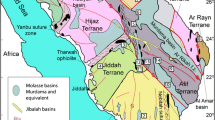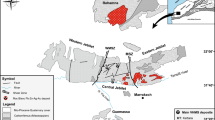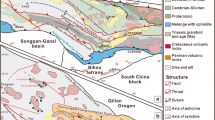Abstract
The Granny Smith (37 t Au production) and Wallaby deposits (38 t out of a 180 t Au resource) are located northeast of Kalgoorlie, in 2.7 Ga greenstones of the Eastern Goldfields Province, the youngest orogenic belt of the Yilgarn craton, Western Australia. At Granny Smith, a zoned monzodiorite–granodiorite stock, dated by a concordant titanite–zircon U–Pb age of 2,665 ± 3 Ma, cuts across east-dipping thrust faults. The stock is fractured but not displaced and sets a minimum age for large-scale (1 km) thrust faulting (D2), regional folding (D1), and dynamothermal metamorphism in the mining district. The local gold–pyrite mineralization, controlled by fractured fault zones, is younger than 2,665 ± 3 Ma. In augite–hornblende monzodiorite, alteration progressed from a hematite-stained alkali feldspar–quartz–calcite assemblage and quartz–molybdenite–pyrite veins to a late reduced sericite–dolomite–albite assemblage. Gold-related monazite and xenotime define a U–Pb age of 2,660 ± 5 Ma, and molybdenite from veins a Re–Os isochron age of 2,661 ± 6 Ma, indicating that mineralization took place shortly after the emplacement of the main stock, perhaps coincident with the intrusion of late alkali granite dikes. At Wallaby, a NE-trending swarm of porphyry dikes comprising augite monzonite, monzodiorite, and minor kersantite intrudes folded and thrust-faulted molasse. The conglomerate and the dikes are overprinted by barren (<0.01 g/t Au) anhydrite-bearing epidote–actinolite–calcite skarn, forming a 600-m-wide and >1,600-m-long replacement pipe, which is intruded by a younger ring dike of syenite porphyry pervasively altered to muscovite + calcite + pyrite. Skarn and syenite are cut by pink biotite–calcite veins, containing magnetite + pyrite and subeconomic gold–silver mineralization (Au/Ag = 0.2). The veins are associated with red biotite–sericite–calcite–albite alteration in adjacent monzonite dikes. Structural relations and the concordant titanite U–Pb age of the skarn constrain intrusion-related mineralization to 2,662 ± 3 Ma. The main-stage gold–pyrite ore (Au/Ag >10) forms hematite-stained sericite–dolomite–albite lodes in stacked D2 reverse faults, which offset skarn, syenite, and the biotite–calcite veins by up to 25 m. The molybdenite Re–Os age (2,661 ± 10 Ma) of the ore suggests a genetic link to intrusive activity but is in apparent conflict with a monazite–xenotime U–Pb age (2,651 ± 6 Ma), which differs from that of the skarn at the 95% confidence level. The time relationships at both gold deposits are inconsistent with orogenic models invoking a principal role for metamorphic fluids released during the main phase of compression in the fold belt. Instead, mineralization is related in space and time to late-orogenic, magnetite-series, high-Mg monzodiorite–syenite intrusions of mantle origin, characterized by Mg/(Mg + FeTOTAL) = 0.31–0.57, high Cr (34–96 ppm), Ni (22–63 ppm), Ba (1,056–2,321 ppm), Sr (1,268–2,457 ppm), Th (15–36 ppm), and rare earth elements (total REE: 343–523 ppm). At Wallaby, shared Ca–K–CO2 metasomatism and Th-REE enrichment (in allanite) link Au–Ag mineralization in biotite–calcite veins to the formation of the giant epidote skarn, implicating a Th + REE-rich syenite pluton at depth as the source of the oxidized hydrothermal fluid. At Granny Smith, lead isotope data and the Rb–Th–U signature of early hematite-bearing wall-rock alteration point to fluid released by the source pluton of the differentiated alkali granite dikes.










Similar content being viewed by others
References
Barth TFW (1959) Principles of classification and norm calculations of metamorphic rocks. J Geol 67:135–152
Blewett RS, Cassidy KF, Champion DC, Henson PA, Goleby BS, Jones L, Groenewald PB (2004) The Wangkathaa orogeny: an example of episodic regional “D2” in the Late Archaean Eastern Goldfields Province, Western Australia. Precambrian Res 130:139–159
Brown SM, Fletcher IR, Stein HJ, Snee LW, Groves DI (2002a) Geochronological constraints on pre-, syn-, and postmineralization events at the world-class Cleo gold deposit, Eastern Goldfields Province, Western Australia. Econ Geol 97:541–559
Brown SM, Groves DI, Newton PGN (2002b) Geological setting and mineralization model for the Cleo gold deposit, Eastern Goldfields Province, Western Australia. Miner Depos 37:704–721
Bucci LA, McNaughton NJ, Fletcher IR, Groves DI, Kositcin N, Stein HJ, Hagemann SG (2004) Timing and duration of high-temperature gold mineralization and spatially associated granitoid magmatism at Chalice, Yilgarn craton, Western Australia. Econ Geol 99:1123–1144
Cameron EM, Hattori K (1987) Archean gold mineralization and oxidized hydrothermal fluids. Econ Geol 82:1177–1191
Campbell IH, Bitmead J, Hill RI, Schiøtte L, Thom AM (1993) Implications of zircon dates for the age of granite rocks in the Eastern Goldfields Province. Record 1993/54. Australian Geological Survey Organisation, Canberra, pp 47–48
Cassidy KF, Champion DC, Fletcher IR, Dunphy JM, Black LP, Claoue-Long JC (2002) Geochronological constraints on the Leonora–Laverton transect area, northeastern Yilgarn craton. Record 2002/18. Geoscience Australia, Symonston, pp 31–54
Champion DC, Sheraton JW (1997) Geochemistry and Nd isotope systematics of Archaean granites of the Eastern Goldfields, Yilgarn craton, Australia: implications for crustal growth processes. Precambrian Res 83:109–132
Chang LLY, Howie RA, Zussman J (1998) Rock-forming minerals volume 5B—non-silicates: sulphates, carbonates, phosphates, halides. Geological Society London, London, pp 335–352
Cherniak DJ (2006) Pb and rare earth element diffusion in xenotime. Lithos 88:1–14
Corfu F (1993) The evolution of the southern Abitibi greenstone belt in light of precise U–Pb geochronology. Econ Geol 88:1323–1340
Cumming GL, Richards JR (1975) Ore lead isotope ratios in a continuous changing Earth. Earth Planet Sci Lett 28:155–171
Duncan RK, Willett GC (1990) Mount Weld carbonatite. In: Hughes FE (ed) Geology of mineral deposits of Australia and Papua New Guinea. Monograph 14. The Australasian Institute of Mining and Metallurgy, Melbourne, pp 591–597
Duuring P, Hagemann SG, Groves DI (2000) Structural setting, hydrothermal alteration, and gold mineralization at the Archaean syenite-hosted Jupiter deposit, Yilgarn craton, Western Australia. Miner Depos 35:402–421
Einaudi MT, Burt DM (1982) Introduction—terminology, classification, and composition of skarn deposits. Econ Geol 77:745–754
Feng R, Fan J, Kerrich R (1993) Noble metal abundances and characteristics of six granitic magma series, Archean Abitibi Belt, Pontiac Subprovince: relationships to metallogeny and overprinting of mesothermal gold deposits. Econ Geol 88:1376–1401
Fletcher IR, Rasmussen B, McNaughton NJ (2000) SHRIMP U–Pb geochronology of authigenic xenotime and its potential for dating sedimentary basins. Aust J Earth Sci 47:845–859
Fletcher IR, Dunphy JM, Cassidy KF, Champion DC (2001) Compilation of SHRIMP U–Pb geochronological data, Yilgarn Craton, Western Australia, 2000–2001. Record 2001/47. Geoscience Australia, Symonston, 111 pp
Gardes E, Jaoul O, Montel J-M, Seydoux-Guillaume A-M, Wirth R (2006) Pb diffusion in monazite: an experimental study of Pb2+ + Th4+ ⇔ 2Nd3+ interdiffusion. Geochim Cosmochim Acta 70:2325–2336
Goldfarb RJ, Baker T, Dubé B, Groves DI, Hart CJR, Gosselin P (2005) Distribution, character and genesis of gold deposits in metamorphic terranes. In: Hendequist JW, Thompson JFH, Goldfarb RJ, Richards JP (eds) Economic Geology 100th Anniversary Volume. Society of Economic Geologist Inc., Littleton, Colorado, pp 407–450
Grant JA (1986) The isocon diagram—a simple solution to Gresen’s equation for metasomatic alteration. Econ Geol 81:1976–1982
Groves DI, Goldfarb RJ, Gebre-Mariam M, Hagemann SG, Robert F (1998) Orogenic gold deposits: a proposed classification in the context of their crustal distribution and relationship to other deposit types. Ore Geol Rev 13:7–27
Hall GC, Holyland PW (1990) Granny Smith gold deposit. In: Hughes FE (ed) Geology of the mineral deposits of Australia and Papua New Guinea. Monograph 14. Australasian Institute of Mining and Metallurgy, Melbourne, pp 519–524
Hallberg JA (1985) Geology and mineral deposits of the Leonora–Laverton area, northeastern Yilgarn Block, Western Australia. Hesperian, Perth, pp 140
Hallberg JA (1987) Postcratonization mafic and ultramafic dykes of the Yilgarn Block. Aust J Earth Sci 34:135–149
Jaffey AH, Flynn LF, Glendenin LE, Bentley WC, Essling AM (1971) Precision measurements of half-lives and specific activities of 235U and 238U. Phys Rev C4:1889–1906
Kelley DL, Kelley KD, Coker WB, Caughlin B, Doherty ME (2006) Beyond the obvious limits of ore deposits: the use of mineralogical, geochemical, and biological features for the remote detection of mineralization. Econ Geol 101:729–752
Krapez B, Brown SJA, Hand J, Barley ME, Cas RAF (2000) Age constraints on recycled crustal and supracrustal sources of Archaean metasedimentary sequences, Eastern Goldfields Province, Western Australia: evidence from SHRIMP zircon dating. Tectonophysics 322:89–133
Kretz R (1983) Symbols for rock-forming minerals. Am Mineral 68:277–279
Le Maitre RW (1976) Some problems of the projection of chemical data into mineralogical classifications. Contrib Mineral Petrol 56:181–189
Ludwig KR (1993) PBDAT—a computer program for processing Pb–U–Th isotope data. Open-File Report 88–542. U.S. Geological Survey, Reston, 32 pp
Ludwig KR (2000) Decay constant errors in U–Pb Concordia-intercept ages. Chem Geol 166:315–318
Ludwig KR (2001) SQUID 1.02—a user’s manual. Special Publication 2. Berkeley Geochronology Center, Berkeley, 19 pp
Ludwig KR (2003) Users manual for Isoplot 3.00—a geochronological toolkit for Microsoft Excel. Special Publication 4. Berkeley Geochronology Center, Berkeley, 70 pp
Markey RJ, Stein HJ, Morgan JW (1998) Highly precise Re–Os dating of molybdenite using alkaline fusion and NTIMS. Talanta 45:935–946
Marsh TM, Einaudi MT, McWilliams M (1997) 40Ar–39Ar geochronology of Cu–Au and Au–Ag mineralization in the Poterillos district, Chile. Econ Geol 92:784–806
Martin H, Smithies RH, Rapp R, Moyen JF, Champion D (2005) An overview of adakite, tonalite–trondhjemite–granodiorite (TTG), and sanukitoid: relationships and some implications for crustal evolution. Lithos 79:1–24
Mueller AG (2007) Copper–gold endoskarns and high-Mg monzodiorite–tonalite intrusions at Mt Shea, Kalgoorlie, Australia: implications for the origin of gold–pyrite–tennantite mineralization in the Golden Mile. Miner Deposita 42:737–769
Mueller AG, Campbell IR, Schiøtte L, Sevigny JH, Layer PW (1996) Constraints on the age of granitoid emplacement, metamorphism, gold mineralization and subsequent cooling of the Archean greenstone terrane at Big Bell, Western Australia. Econ Geol 91:896–915
Mueller AG, Nemchin AA, Frei R (2004) The Nevoria gold skarn deposit, Southern Cross greenstone belt, Western Australia: II. Pressure–temperature–time path and relationship to postorogenic granites. Econ Geol 99:453–478
Nakamura N (1974) Determination of REE, Ba, Mg, Na and K in carbonaceous and ordinary chondrites. Geochim Cosmochim Acta 38:757–775
Ojala VJ (1995) Structural and depositional controls on gold mineralization at the Granny Smith mine, Laverton, Western Australia. Ph.D. thesis, University of Western Australia, Perth, 184 pp
Ojala VJ, Ridley JR, Groves DI, Hall GC (1993) The Granny Smith gold deposit: the role of heterogenous stress distribution at an irregular granitoid contact in a greenschist facies terrane. Miner Depos 28:409–419
Ojala VJ, McNaughton NJ, Ridley JR, Groves DI, Fanning CM (1997) The Archaean Granny Smith gold deposit, Western Australia: age and Pb-isotope tracer studies. Chron Rech Min 529:75–89
Parrish RR (1990) U–Pb dating of monazite and its application to geological problems. Can J Earth Sci 27:1431–1450
Parrish RR, Krogh TE (1987) Synthesis and purification of 205Pb for U–Pb geochronology. Chem Geol 66:103–110 (Isotope Geoscience Section)
Read D, Andreoli MAG, Knoper M, Williams CT, Jarvis N (2002) The degradation of monazite: implications for the mobility of rare-earth and actinide elements during low-temperature alteration. Eur J Mineral 14:487–498
Rittmann A (1973) Stable mineral assemblages of igneous rocks. Springer, Berlin Heidelberg New York, 262 pp
Robert F (2001) Syenite-associated disseminated gold deposits in the Abitibi greenstone belt, Canada. Miner Depos 36:503–516
Robert F, Poulsen KH, Cassidy KF, Hodgson CJ (2005) Gold metallogeny of the Superior and Yilgarn cratons. In: Hedenquist JW, Thompson JFH, Goldfarb RJ, Richards JP (eds) Economic Geology 100th Anniversary Volume. Society of Economic Geologist Inc., Littleton, Colorado, pp 1001–1033
Salier BP (2004) The timing and source of gold-bearing fluids in the Laverton greenstone belt, Yilgarn craton, Western Australia. Ph.D. thesis, University of Western Australia, Perth, 379 pp
Salier BP, Groves DI, McNaughton NJ, Fletcher IR (2004) The world-class Wallaby gold deposit, Laverton, Western Australia: an orogenic-style overprint on a magmatic–hydrothermal magnetite–calcite alteration pipe. Miner Depos 39:473–494
Salier BP, Groves DI, McNaughton NJ, Fletcher IR (2005) Geochronological and stable isotope evidence for widespread orogenic gold mineralization from a deep-seated fluid source at ca. 2.65 Ga in the Laverton Gold Province, Western Australia. Econ Geol 100:1363–1388
Selby D, Creaser RA (2004) Macroscale NTIMS and microscale LA–MC–ICP–MS Re–Os isotopic analysis of molybdenite: testing spatial restrictions for reliable Re–Os age determinations, and implications for the decoupling of Re and Os within molybdenite. Geochim Cosmochim Acta 68:3897–3908
Smithies RH, Champion DC (1999) Late Archaean felsic alkaline igneous rocks in the Eastern Goldfields, Yilgarn Craton, Western Australia: a result of lower crustal delamination? J Geol Soc (Lond) 156:561–576
Smoliar MI, Walker RJ, Morgan JW (1996) Re–Os isotope constraints on the age of Group IIA, IIIA, IVA, and IVB iron meteorites. Science 271:1099–1102
Spear FS (1993) Metamorphic phase equilibria and pressure–temperature–time paths. Monograph no. 1. Mineralogical Society of America, Chantilly, 719 pp
Stein HJ, Markey RJ, Morgan JW, Hannah JL, Schersten A (2001) The remarkable e-Os chronometer in molybdenite: how and why it works. Terra Nova 13:479–486
Streckeisen A (1976) To each plutonic rock its proper name. Earth Sci Rev 12:1–33
Streckeisen A (1979) Classification and nomenclature of volcanic rocks, lamprophyres, carbonatites, and melilitic rocks: recommendations and suggestions of the IUGS subcommission on the systematics of igneous rocks. Geology 7:331–335
Sutcliffe RH, Smith AR, Doherty W, Barnett RL (1990) Mantle derivation of Archean amphibole-bearing granitoid and associated mafic rocks: evidence from the southern Superior Province, Canada. Contrib Mineral Petrol 105:255–274
Sutcliffe RH, Barrie CT, Burrows DR, Beakhouse GP (1993) Plutonism in the southern Abitibi Subprovince: a tectonic and petrogenetic framework. Econ Geol 88:1359–1375
Teufel S, Heinrich W (1997) Partial resetting of the U–Pb isotope system in monazite through hydrothermal experiments: an SEM and U–Pb isotope study. Chem Geol 137:273–281
Thorpe RI (1999) The Pb isotope linear array for volcanogenic massive sulfide deposits of the Abitibi and Wawa Subprovinces, Canadian Shield. Econ Geol Monogr 10:555–576
Winchester JA, Floyd PA (1977) Geochemical discrimination of different magma series and their differentiation products using immobile elements. Chem Geol 20:325–343
Wimmenauer W (1985) Petrographie der magmatischen und metamorphen Gesteine. Ferdinand Enke Verlag, Stuttgart, 382 pp
Acknowledgments
The authors thank Placer Dome Asia Pacific Limited for sponsoring the chronologic and petrographic research, and for the permission to publish the results of their consulting work carried out in the Granny Smith–Wallaby district during the past 10 years. Francois Robert, Barrick Gold Corporation, kindly supported the completion of this study. Bruce Robertson guided us during open-pit and underground visits at Wallaby, and contributed to our understanding of the mine geology. Mark Pirlo generously helped with the collection of sample material.
Author information
Authors and Affiliations
Corresponding author
Additional information
Editorial handling: B. Lehmann
Rights and permissions
About this article
Cite this article
Mueller, A.G., Hall, G.C., Nemchin, A.A. et al. Archean high-Mg monzodiorite–syenite, epidote skarn, and biotite–sericite gold lodes in the Granny Smith–Wallaby district, Australia: U–Pb and Re–Os chronometry of two intrusion-related hydrothermal systems. Miner Deposita 43, 337–362 (2008). https://doi.org/10.1007/s00126-007-0164-0
Received:
Accepted:
Published:
Issue Date:
DOI: https://doi.org/10.1007/s00126-007-0164-0




